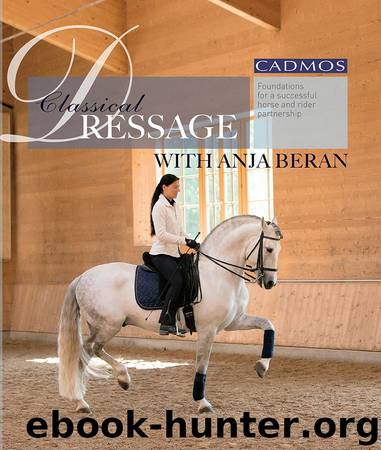Classical Dressage With Anja Beran by Anja Beran

Author:Anja Beran
Language: deu
Format: epub
ISBN: 9783840469244
Publisher: Cadmos Verlag
Published: 2014-11-15T00:00:00+00:00
* * *
Potential problems in training the piaffe
My horse pulls on the reins and raises its croup.
Two problems are being referred to at the same time here because they often occur together. Even if a horse only has one of these problems, the cause and remedy are the same. The cause is that the horse is on the forehand, i.e. it is not in balance and therefore it is not using its back. What should I do? Such horses should be ridden a lot at walk and trot in the lateral movements, particularly stepping over, to make them light on the reins. The horse should never be allowed to lean on the reins. It is essential to ensure that the head and neck are in self-carriage. This is achieved by making them as diligent and mobile as possible in the hindquarters. For this purpose many changes between the lateral movements are appropriate, in combination with frequent downward transitions to halt, reining back and stepping off again. Gradually such horses will elevate themselves automatically at the front and get larger in the forehand. This is essential in order for the hindquarters to take up weight! Once more basic work has been done and the rider has the impression that the horse is in better balance – incidentally a reliable check here is good chewing on the bit – it is time to think again about attempting the first piaffe steps. In this context the rider must sit completely upright and hold the hands slightly higher than normal, but keep them close together! It is possible to imagine letting the horse’s forehand grow larger and wanting to press the hindquarters down. The muscle system at the base of the neck now becomes significant because, if this is not well developed, it is very difficult for the horse to straighten and carry itself. It is almost always the case that horses which have been ridden very deep and/or over-bent for a long time have not been able to develop these muscles and consequently have considerable problems when it is a question of performing the collected movements. If a trainer with a touching whip is available, they should touch such horses as deep as possible, ideally on the fetlock, and under no circumstances on the croup. Why? This would make the croup go even higher and the whip would teeter against it! The aim is to achieve the opposite: the croup is to be lowered with these horses. In order to stimulate increased stepping over of the hind legs, it is recommended to touch deep, and therefore I would recommend trying to touch the horse on the fetlock. This tip will help with many horses but, as usual, exceptions confirm the rule. Ultimately the competence of the trainer enables them quickly to find the best point to support the movement with the whip. Frequent reining back, between piaffe steps, but not with a deep, contracted neck, concludes the gymnastic exercise and also helps to relieve the forehand.
Download
This site does not store any files on its server. We only index and link to content provided by other sites. Please contact the content providers to delete copyright contents if any and email us, we'll remove relevant links or contents immediately.
| Equestrian | Polo |
| Racing |
Shoe Dog by Phil Knight(4167)
The Rules Do Not Apply by Ariel Levy(3905)
Walking by Henry David Thoreau(3234)
Running Barefoot by Amy Harmon(3056)
Crazy Is My Superpower by A.J. Mendez Brooks(2860)
How to Read Water: Clues and Patterns from Puddles to the Sea (Natural Navigation) by Tristan Gooley(2854)
I'll Give You the Sun by Jandy Nelson(2842)
How to Read Nature by Tristan Gooley(2665)
How Music Works by David Byrne(2525)
The Boy, the Mole, the Fox and the Horse by Charlie Mackesy(2447)
Seducing Cinderella by Gina L. Maxwell(2235)
Cuba by Lonely Planet(2184)
The Fight by Norman Mailer(2158)
Going Long by Editors of Runner's World(1920)
Accepted by Pat Patterson(1917)
The Unfettered Mind: Writings from a Zen Master to a Master Swordsman by Takuan Soho(1859)
The Happy Runner by David Roche(1821)
Backpacker the Complete Guide to Backpacking by Backpacker Magazine(1815)
Trail Magic by Trevelyan Quest Edwards & Hazel Edwards(1760)
